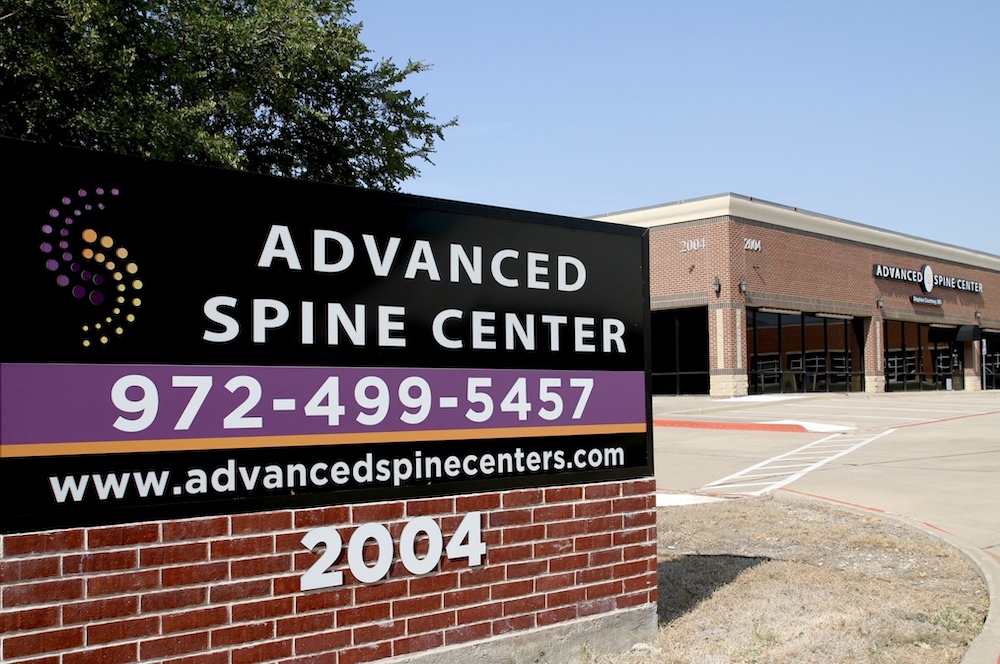Specialties

If you need professional sciatica treatment in Plano, TX, look no further than Advanced Spine Center. We understand that sciatica can result in severe pain, which can significantly impact daily life and mobility. That’s why we offer the residents of Northeast Texas a variety of individualized treatments for sciatica.
Led by Dr. Stephen Courtney, our dedicated specialists offer a range of advanced sciatica treatment options. Our goal is to provide relief from pain and discomfort through surgical interventions and alternative therapies, depending on the severity and underlying cause of your sciatic nerve pain.
Our state-of-the-art facility in Plano, TX, is equipped with the latest technology and staffed by compassionate professionals who prioritize patient care and comfort. We believe in empowering our patients with knowledge about their condition and treatment options, ensuring informed decisions and effective outcomes.
Call (972) 499-5457 to schedule an appointment with us regarding your sciatic pain today.
Effective Treatments for Sciatica Pain in Plano, TX
At the Advanced Spine Center in Plano, TX, we offer a range of effective treatments for sciatica pain. Our more conservative treatment options include medications and injections to reduce inflammation and pain.
For more severe cases, we provide advanced interventions such as epidural steroid injections to alleviate nerve irritation. If necessary, you can schedule surgery with a Plano laminectomy specialist on our team.
Sciatic Nerve Anatomy
The sciatic nerve is the largest nerve in the human body, and it originates from the nerve roots that extend outwards from the L4 to S3 portions of the spine. It extends through the buttocks and down the back of each leg, branching outward into smaller nerves that supply sensation and motor function to the thigh, calf, foot, and toes.
The sciatic nerve plays a crucial role in facilitating movement within the lower half of the body. Similarly to other spinal nerves, the sciatic nerve is also responsible for transmitting sensory information from the lower extremities to the spinal cord and brain.
What Is Sciatica?

Sciatica is a condition caused by compression or irritation of the sciatic nerve. It is characterized by pain that radiates along the path of the sciatic nerve, including the lower back region, as well as the hip and leg on the affected side.
Bilateral Sciatica
Bilateral sciatica is a condition where both sciatic nerves, one on each side of the body, are affected simultaneously. This typically results in pain, tingling, numbness, or weakness in both legs.
Bilateral sciatica is less common than unilateral sciatica and may indicate more serious underlying conditions, such as severe spinal stenosis, large herniated discs, or central spinal canal issues.
Piriformis Syndrome vs Sciatica
Piriformis syndrome and sciatica both involve irritation of the sciatic nerve, but their causes differ. Sciatica is usually due to spinal issues like a herniated disc or spinal stenosis, causing nerve compression at the spinal level.
Piriformis syndrome occurs when the piriformis muscle in the buttocks spasms or tightens, compressing the sciatic nerve beneath it. While both conditions cause similar symptoms of pain, tingling, and numbness in the leg, piriformis syndrome originates from the muscle rather than spinal problems.
Sciatica Symptoms

Symptoms of sciatica can include:
- Sharp or shooting back pain, buttock pain, and leg pain
- Tingling or burning sensations in the leg
- Numbness or muscle weakness in the affected leg or foot
- Difficulty moving the leg or foot
- Pain that worsens with prolonged sitting or standing
- A constant pain on one side of the lower back
- In severe cases, loss of bowel or bladder control
If you have been experiencing the symptoms of sciatica and you begin losing bowel or bladder function, seek medical attention immediately. Your sciatica could result in permanent incontinence and widespread nerve damage if not treated in a timely manner.
What Does Sciatica Feel Like?
Sciatica typically feels like a sharp, shooting pain that radiates from the lower back through the buttock and down the back of the leg. It can also cause tingling, burning sensations, or numbness in the leg. Some individuals may experience muscle weakness or difficulty moving the affected leg.
The pain can range from mild to severe and often worsens with prolonged sitting, standing, or sudden movements. It may also feel worse in the mornings if you sleep on the affected side.
How Long Does Sciatica Last?
The duration of sciatica can vary widely depending on its cause and severity. Acute sciatica often lasts between a few days to a few weeks and may resolve on its own with rest and self-care measures.
Chronic sciatica, which persists for more than three months, may require more intensive treatment such as physical therapy, medications, or even surgery.
What Causes Sciatica?
Sciatica is the result of sciatic nerve compression/irritation, which can be caused by other spinal conditions or injuries. Some common sciatica causes include spinal stenosis, a herniated disk, degenerative disc disease, spondylolisthesis, and piriformis muscle spasms. Sciatica can also be the result of tumors or infections affecting the spine.
Some of the risk factors for sciatica include the above spinal conditions, as well as a sedentary lifestyle or occupations that involve heavy lifting or twisting motions.
How to Diagnose Sciatica
Sciatica is diagnosed through a combination of medical history, physical examination, and diagnostic tests. During the physical exam, a doctor may check muscle strength, reflexes, and the ability to perform movements like walking on heels or toes.
Imaging tests, such as X-rays, MRI, or CT scans, can help identify the underlying cause by providing detailed views of the spine and surrounding structures. If you’re looking to have sciatica diagnosed by a medical professional, call Advanced Spine Center today and schedule an appointment with a member of our team.
Sciatica Treatment Options in Plano, TX

There are various treatment options that can help relieve sciatica pain and allow patients to live their lives without the burden of sciatic pain. Below are some of the most commonly used sciatica treatment options, as well as the various treatments available through Advanced Spine Center.
Sciatica Medication
Over-the-counter painkillers and prescription medications are often the first line of treatment for sciatic pain. At Advanced Spine Center in Plano, TX, our specialists prescribe anti-inflammatory drugs, muscle relaxants, and pain relievers to reduce discomfort and inflammation associated with sciatic nerve irritation.
Physical Therapy for Sciatica
Physical therapy is another more conservative treatment option for sciatica. Licensed physical therapists design personalized exercise programs focused on strengthening core muscles, improving flexibility, and correcting posture to alleviate pressure on the sciatic nerve. Massage therapy from a physical therapist could also aid in pain reduction.
Sciatica Epidural Steroid Injection in Plano
If medication and physical therapy don’t help, steroid injections can help reduce pain along the sciatic nerve. At Advanced Spine Center, we offer low-back corticosteroid injections, including lumbar injections, that are designed to help relieve sciatica pain and allow you to more easily participate in physical therapy and other physical activities.
Sciatica Surgery in Plano
For severe cases of sciatica resistant to conservative treatments, Advanced Spine Center provides advanced surgical options in Plano, TX. Our experienced spine surgeons specialize in minimally invasive procedures such as laminectomy and herniated disk procedures, aimed at relieving pressure on the sciatic nerve and nerve roots.
Sciatica FAQs
What Kind of Doctor Treats Sciatica?
Sciatica is typically treated by doctors specializing in orthopedics or neurosurgery, particularly those with expertise in spine care.
At Advanced Spine Center in Plano, TX, Dr. Stephen Courtney, an experienced spine surgeon, is skilled in diagnosing and treating sciatica. He offers comprehensive care ranging from conservative treatments like medication therapy to advanced surgical interventions like laminectomy.
Can Sciatica Cause Knee Pain?
Yes, sciatica can cause knee pain. The sciatic nerve runs from the lower back down the leg and to the knee. When it is compressed or irritated, it can radiate pain along its path, which can include the knee.
This pain may manifest as a sharp or shooting sensation, tingling, numbness, or weakness in the knee area, depending on the severity and location of the nerve compression.
Is Walking Good for Sciatica?
Yes, walking can be beneficial for sciatica in many cases. It helps to strengthen the muscles supporting the spine, improve flexibility, and promote circulation, which can aid in reducing inflammation and relieving pressure on the sciatic nerve, which can decrease pain.
However, it’s important to start slowly and avoid activities that worsen pain. Be sure to consult your doctor if walking is worsening your sciatic nerve pain, as they may recommend other exercises.
What Is Stage 4 Sciatica?
Stage 4 sciatica typically refers to severe and chronic sciatic nerve pain that significantly impairs daily functioning. It may indicate long-standing compression or irritation of the sciatic nerve, often due to conditions like advanced disc herniation, severe spinal stenosis, or persistent nerve root compression.
Can Sciatica Cause Groin Pain?
Yes, sciatica can cause groin pain. The sciatic nerve branches out from the lower back and travels down each leg, and when it is compressed or irritated, it can radiate pain along its pathway. This can include pain that extends into the groin area, often described as a dull ache or sharp pain.
Is Sciatica a Disability?
Individuals with some of the more severe symptoms of sciatica may meet the requirements for disability classification. However, individuals who respond well to conservative treatments or more invasive treatments like surgery would likely not be considered disabled as a result of their sciatica.
Contact the Advanced Spine Center for Sciatica Treatments in Plano, TX

Contact the Advanced Spine Center in Plano, TX, today to explore effective treatments for sciatica that are tailored to your unique needs. Our team is skilled at diagnosing sciatica and providing a variety of treatment and pain relief options for those suffering from sciatic nerve pain.
Whether you’re experiencing mild discomfort or debilitating pain, our team is dedicated to diagnosing the underlying cause of your sciatica and developing a personalized treatment plan. Led by skilled specialist Dr. Stephen Courtney, our clinic offers a variety of spinal services, with treatments ranging from conservative therapies to advanced surgical options.
Don’t let sciatic pain keep you down–call (972) 499-5457 or contact us via our website to schedule an appointment with us to discuss your pain and your potential treatment options.


